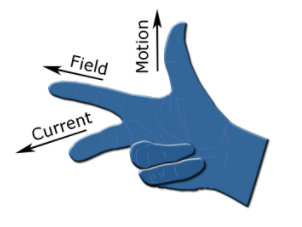
Which rule is used to know the direction of induced current in a circuit?
A. Galvanometer
B. Fleming’s right-hand rule
C. Right-hand thumb rule.
D. Fleming’s left-hand rule
Answer
576.9k+ views
Hint: When a conductor is in motion in a uniform magnetic field, there will be currently generated in the current-carrying conductor. This is the statement of Faraday’s law of induction. Then the direction of current induced in that current-carrying conductor is stated by Fleming’s right-hand rule.
Complete step by step solution:
(i) Faraday’s law of induction: When a current-carrying conductor is in uniform motion in a uniform magnetic field, there will be current induced in that current-carrying conductor.
(ii) Fleming’s right-hand rule: Fleming’s right-hand rule gives the direction of the current in the conductor which is moving in the uniform magnetic field.

The rule states that stretch the thumb, forefinger, and the middle finger of the right hand in a way that they are in the mutually perpendicular direction as shown in the figure. Then, the thumb points the direction of motion of the conductor, the forefinger points the direction of the uniform magnetic field from north pole to the south pole, and the middle finger points the direction of the induced or generated current within the conductor from the terminal of lower electric potential to the terminal of higher electric potential.
Hence, option (B) is correct.
Note:
There is a simple way to recall Fleming’s right-hand rule is the ‘FBI’. F stands for Force ( or the motion of conductor), $B$ stands for the magnetic field and $I$ is for induced current in the conductor. It is followed by counting the letters in ‘FBI’ as from the top of your hand, the thumb is for $F$, the forefinger is for magnetic field and the middle finger is for induced current.
Complete step by step solution:
(i) Faraday’s law of induction: When a current-carrying conductor is in uniform motion in a uniform magnetic field, there will be current induced in that current-carrying conductor.
(ii) Fleming’s right-hand rule: Fleming’s right-hand rule gives the direction of the current in the conductor which is moving in the uniform magnetic field.

The rule states that stretch the thumb, forefinger, and the middle finger of the right hand in a way that they are in the mutually perpendicular direction as shown in the figure. Then, the thumb points the direction of motion of the conductor, the forefinger points the direction of the uniform magnetic field from north pole to the south pole, and the middle finger points the direction of the induced or generated current within the conductor from the terminal of lower electric potential to the terminal of higher electric potential.
Hence, option (B) is correct.
Note:
There is a simple way to recall Fleming’s right-hand rule is the ‘FBI’. F stands for Force ( or the motion of conductor), $B$ stands for the magnetic field and $I$ is for induced current in the conductor. It is followed by counting the letters in ‘FBI’ as from the top of your hand, the thumb is for $F$, the forefinger is for magnetic field and the middle finger is for induced current.
Recently Updated Pages
A man running at a speed 5 ms is viewed in the side class 12 physics CBSE

The number of solutions in x in 02pi for which sqrt class 12 maths CBSE

State and explain Hardy Weinbergs Principle class 12 biology CBSE

Write any two methods of preparation of phenol Give class 12 chemistry CBSE

Which of the following statements is wrong a Amnion class 12 biology CBSE

Differentiate between action potential and resting class 12 biology CBSE

Trending doubts
What are the major means of transport Explain each class 12 social science CBSE

Which are the Top 10 Largest Countries of the World?

Draw a labelled sketch of the human eye class 12 physics CBSE

Explain sex determination in humans with line diag class 12 biology CBSE

Explain sex determination in humans with the help of class 12 biology CBSE

Differentiate between homogeneous and heterogeneous class 12 chemistry CBSE




